background-image: url(img/people.png) .left-column50[ # Week 3: More Assessment! CSEP 590b, Winter 2023 ] --- name: normal layout: true class: --- # Important Reminder ## This is an important reminder ## Make sure zoom is running and recording!!! --- [//]: # (Outline Slide) # Learning Goals for Today - What are trade offs between assessment techniques - Example of a carefully designed empirical study --- # Many Possible Techniques for Assessment Learning design guidelines (baseline for any other technique) Automated Assessment Simulation/Using accessibility Tools User Studies (focus of next week) --- # Which one Should You Use? What technique will find the most user accessibility problems? What technique will find the most guideline violations? What techniques could someone without accessibility training successfully use? How do you trade off cost & value? How do you get a system to the point where user testing is worth doing? --- # Study to answer these questions [Is your web page accessible? A comparative study...](https://dl.acm.org/doi/10.1145/1054972.1054979) Gather baseline problem data on 4 sites - Usability study Test same sites with other techniques - Expert review with guidelines - Screen reader - Automated tool - Remote Compare problems found to baseline study --- # Baseline Study 5 blind JAWS users - 2 to 6+ years of experience - Used web for e-mail, shopping, information, and news 4 tasks (each on a different site) - Range of difficulty - Representative activities: bus trip planner; find names on a page; register for a class; grocery item search --- # Think Aloud Protocol Focused analysis on *accessibility* problems (not *usability* or *technology* problems) - [+] “Pop up. Had to ask for sighted help to continue” - [+] “Date entered in incorrect format” - [-] “Their slogan is annoying” - [-] “Forgot JAWS command for forms mode” Ranked problems by severity, found 3-10 per site Grouped like problems (e.g. all encounters with the pop-up window) ??? AT the time, WCAG 1; Meeting WCAG priority 1 guidelines did not address all severe problems --- # Results -- Grocery .left-column50[ 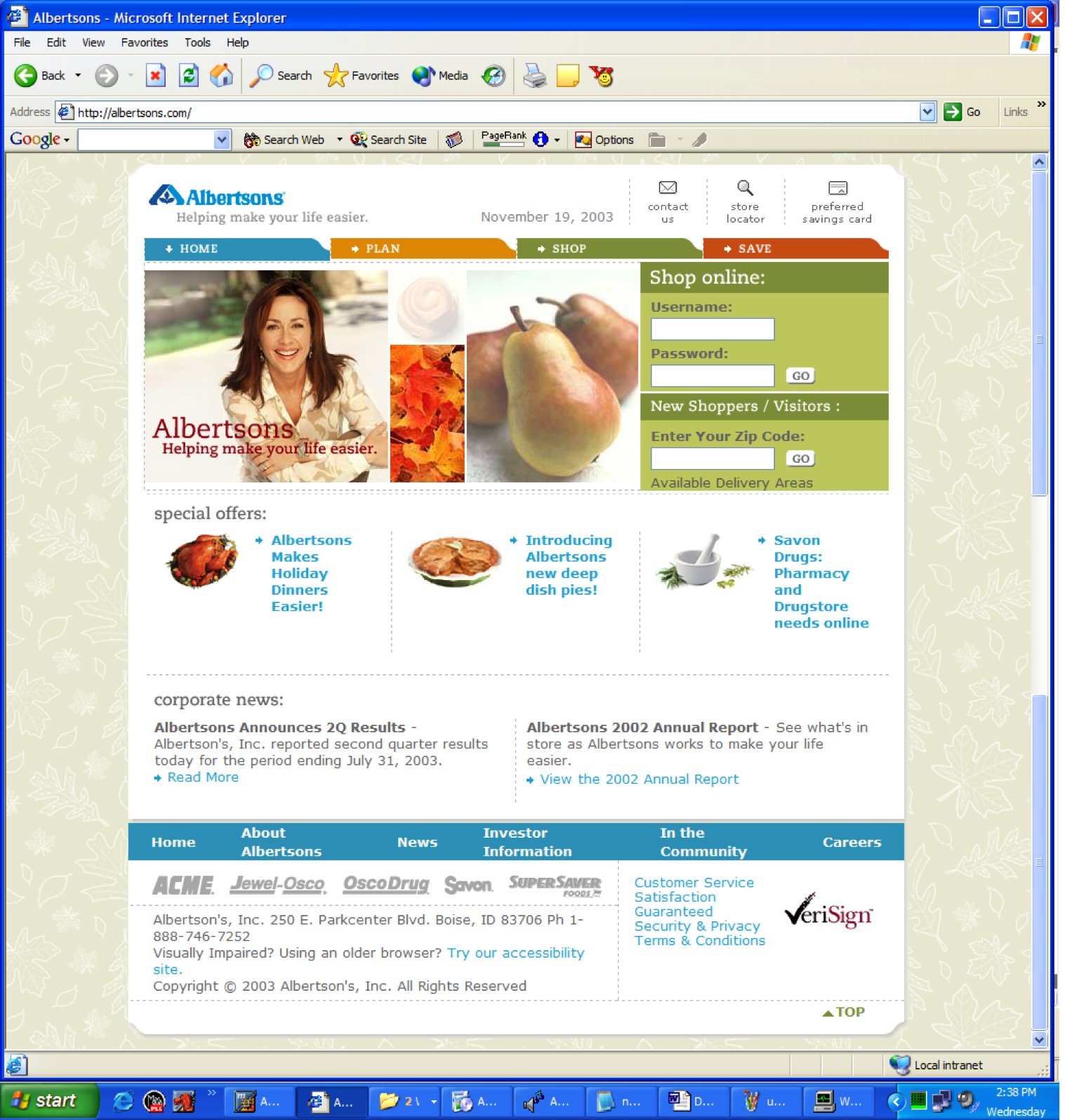 ] .right-column50[ 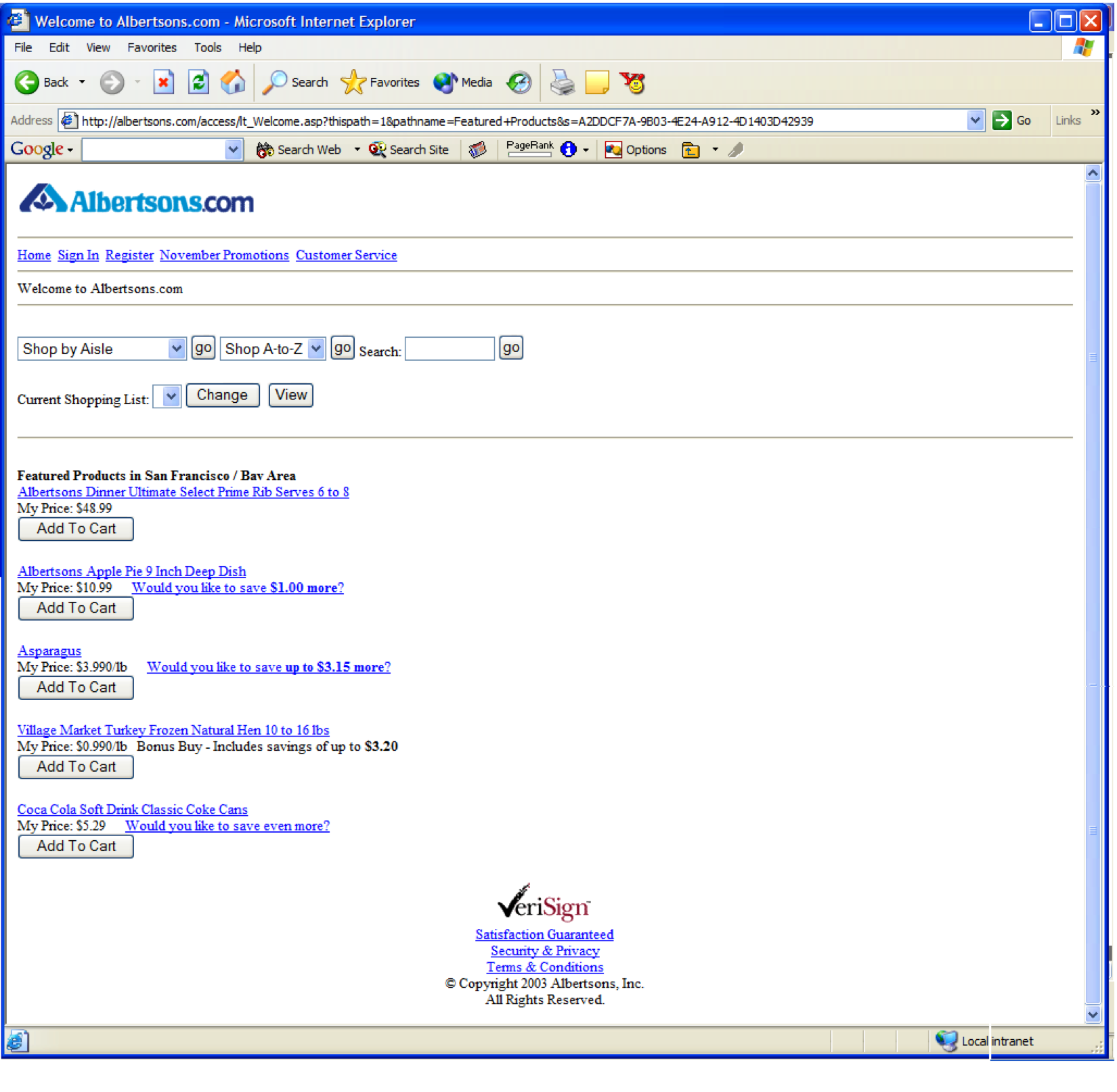 ] --- # Results -- Grocery .left-column50[ Special, accessible website Easiest site 7 accessibility problems - Redundant text - Problems with forms … ] .right-column50[  ] --- # Results -- Find Names .left-column50[ 2 simple HTML pages 3 accessibility problems - Front page: Use of headers confusing - Front page lacked clear description of contents/purpose - Name page: too many links ] .right-column50[ 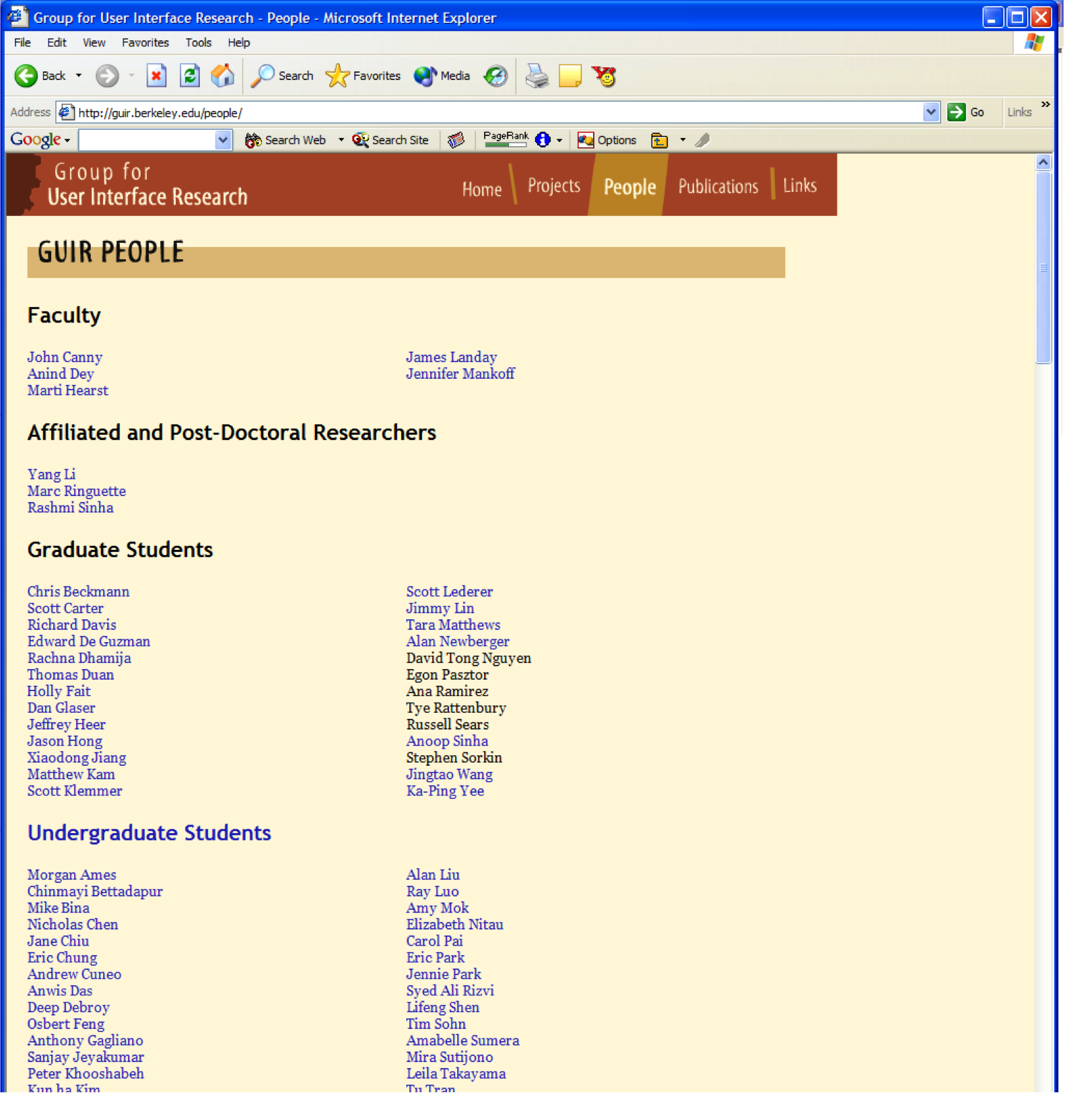 ] --- # Results -- Bus .left-column50[ Most difficult site 10 accessibility problems - Lack of ALT text - Bad form labeling - Non-descriptive link names - Lack of directions/ description of purpose ] .right-column50[ 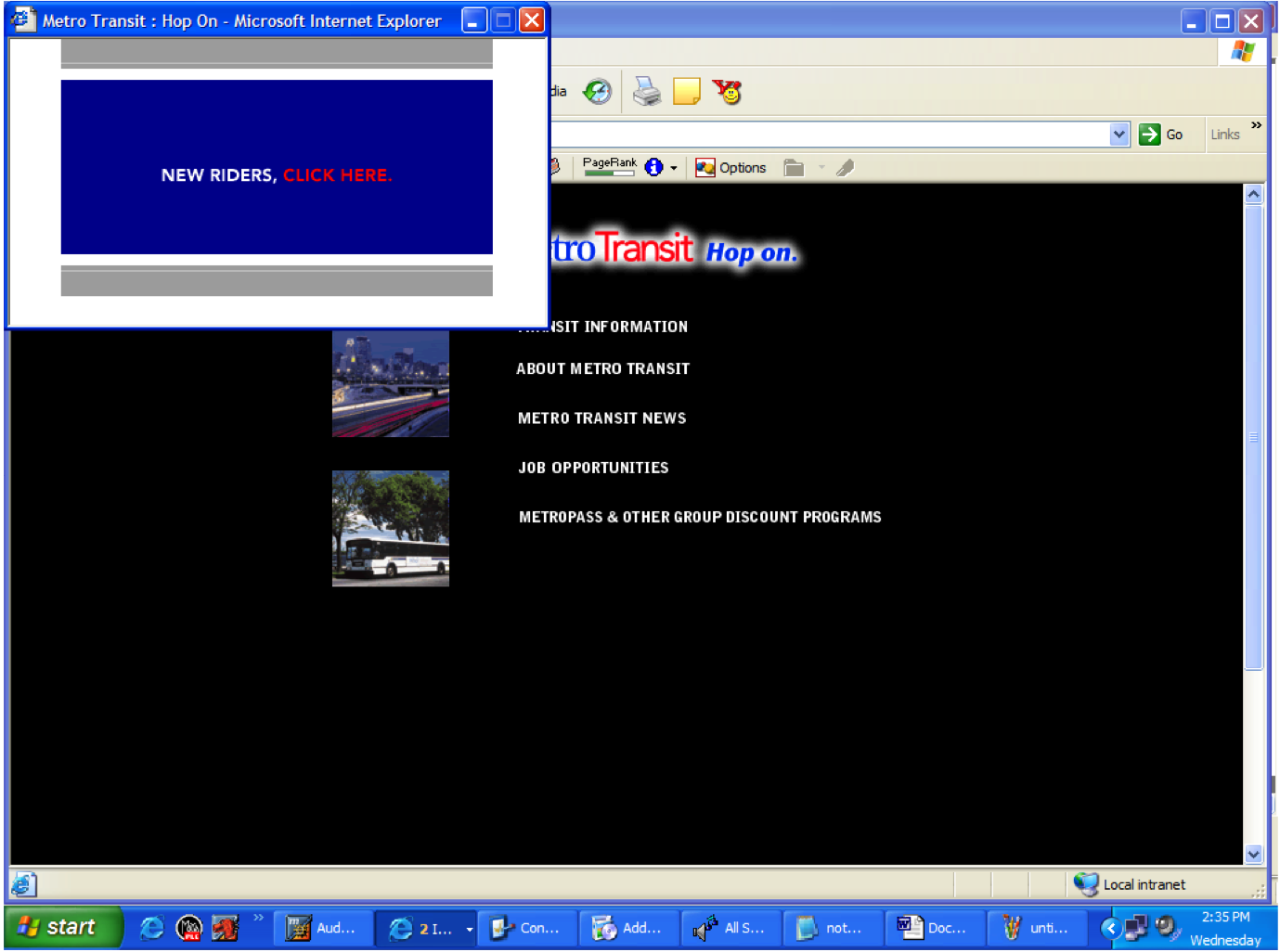 ] --- # Results -- Bus .left-column50[ 1 page 9 accessibility problems - Required field marked only with “bold” text - No directions about syntax requirements - Fields not well labeled … ] .right-column50[  ] --- # Comparative Study Piloted techniques to be compared Gathered data on success of each technique for same tasks as baseline Analyzed results --- # Comparative Study Four conditions - Expert Review (web experts) - Screen Reader (web experts w/ screen reader) - Automated (Bobby) - Remote (expert, remote blind users) Four tasks/sites (same as baseline) - 18 current web developers (2-8 yrs exp) - Never developed an accessible website - Three had taken a class that covered some issues - 9 remote, experienced JAWS users --- # Web Developers All web developers introduced to WCAG Priority 1 guidelines (best available at the time) 8 web developers given a Screen Reader tutorial & practice time (~15mins) Instructed to only review task pages Think aloud method --- # Remote, BLV users Given parallel instructions Asked to email problems back to us --- # Analysis Coded problems: WCAG & Empirical (baseline) Hypothesis 1: No technique will be more effective than any other, where effectiveness is a combination of: - Thoroughness (portion of actual problems) - Validity (false positives) Hypothesis 2: The types of accessibility problems found by each technique will be the same - Categories of problems found by each technique --- # General Results 1-2 hours to complete No correlation between developer severity and WCAG priority or empirical severity 5 of 9 remote participants failed to complete 1 of the 4 tasks --- # H1: Methods Don't Differ .left-column50[ - Screen reader and Expert Review found more problems ] .right-column50[  ] ??? Note small differences between individual developers in finding problems Difference between remote and screen reader group is significant --- # H1: Methods Don't Differ .left-column50[ - Screen reader and Expert Review found more problems - Screen reader and Expert Review most valid ] .right-column50[ 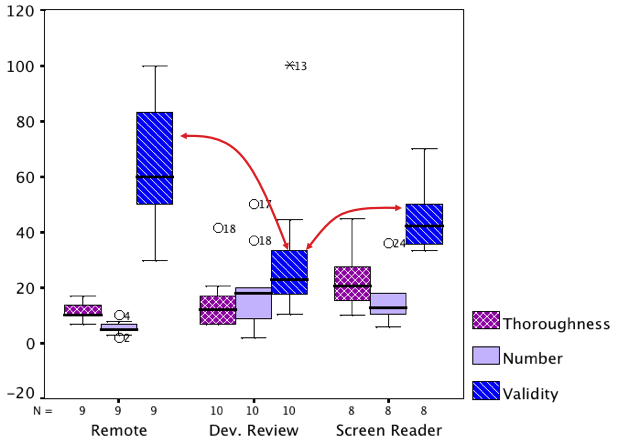 ] ??? Note small differences between individual developers in finding problems Difference between remote and screen reader group is significant --- # H2: Techniques find Different Problems .left-column60[ WCAG 1 | | G1 | G2 | G3 | G4 | G5 | G9 | G10 | G12 | G13 | G14 | |:--------------|:---|:---|:---|:---|:---|:---|:----|:----|:----|:----| | Expert Review | Y | Y | Y | | | Y | Y | Y | Y | | | Screen Reader | Y | Y | Y | Y | | Y | Y | Y | Y | Y | | Remote | Y | Y | | | Y | Y | Y | Y | Y | Y | | Automated | Y | Y | | | Y | | | | Y | | ] .right-column40[ - G1,2: AV alternatives & not just color - G3,4: Good markup and clear language - G5: Tables - G9,10: Device independence & interim solutions for things like JavaScript - G12,13: Context & Navigation - G14; clear and simple text ] --- # H2: Techniques find Different Problems .left-column60[ Empirical | | E1 | E2 | E3 | E4 | E5 | E6 | E7 | E8 | E9 | |:--------------|:---|:---|:---|:---|:---|:---|:---|:---|:---| | Expert Review | Y | Y | Y | Y | | Y | Y | Y | Y | | Screen Reader | Y | | Y | Y | Y | Y | Y | Y | Y | | Remote | Y | | Y | Y | | Y | Y | | Y | | Automated | Y | | | | | | | | | ] .right-column40[ - E1: No alt text - E2: Poor defaults - E3: Poor formatting - E4: Too much data - E6: No directions - E7: Visual pairing - E8: Poor names - E9: Popups ] --- # Aside: WCAG has come a long way Many (perhaps all) of these are part of guidelines now - E1: Should have no alt text - E2: Poor defaults - E3: Poor formatting - E4: Too much data - E6: No directions - E7: Visual pairing - E8: Poor names - E9: Popups --- # H2: Techniques find Different Types of Problems - High variance among individual reviewers - Screen reader novices did best at both major types of problems 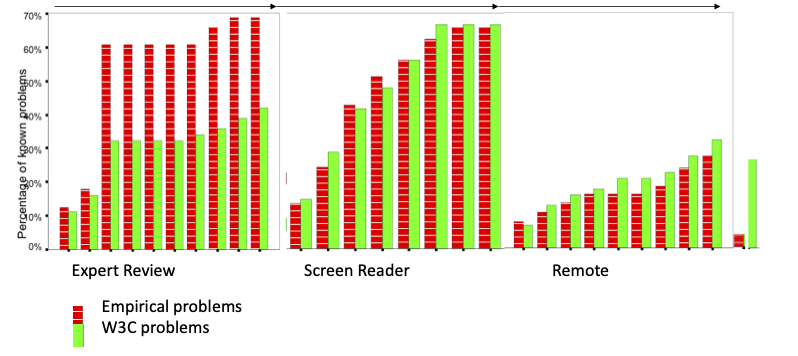 ??? Explain chart also tracks heuristic eval literature: Five Evaluators find ~50% of Problems Individuals don't do well, but they *differ* from each other --- # Discussion Hyp 1: Screen reader most consistently effective Hyp 2: All but automated comparable - Screen missed only tables (w3); poor defaults (empirical) Really need multiple evaluators Remote technique needs improvement, could fare better Accessibility experience would probably change results --- # Discussion Asymptotic testing needed - Can’t be sure we found all empirical problems Falsification testing needed - Are problems not in empirical data set really false positives? More consistent problem reporting & comparison beneficial Limitations - Web only - Design of remote test limited result quality - Very old study --- # Small Group Discussion Find the students who assessed the same website as you. Talk about the UARs you generated. Did you find different problems from other students? Why do you think you did, or did not, find different problems? Post your discussion notes to the Ed Thread for your website. --- [//]: # (Outline Slide) # Learning Goals for Today - What are trade offs between assessment techniques - Example of a carefully designed empirical study